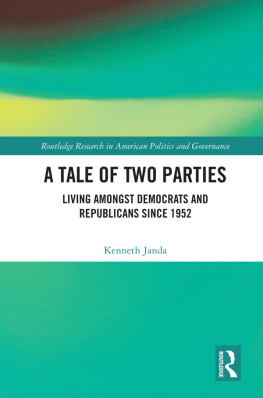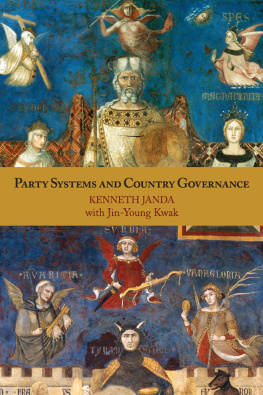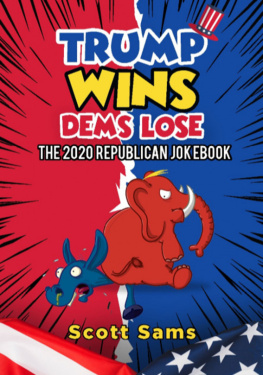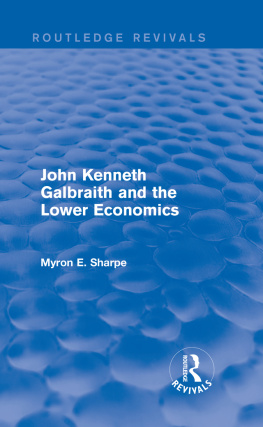A pioneer of the modern social sciences offers a remarkable tale of how American political parties have developed over the past 17 presidential elections. He draws on his own experiences as a citizen, political scientist, student, and mentor, as well as analyses of nearly 70 years of data. Charting the evolving composition of the parties, Professor Janda shows how the social bases of the parties have changed and how social features, rather than ideology, have come to define the Democrats and Republicans. While this raises questions about how well responsible party government works, Professor Janda ends with an optimistic view of the future. This book is a social science masterpiece from which we will all learn.
James Druckman, Professor, Northwestern University
Kenneth Janda inventively examines survey data to uncover the extent to which Republicans and Democrats today are different from those in the 1950s. He documents changes as to how different groups identify with the parties as well as in which groups constitute the base of each party. Janda presents the numbers, but then he delightfully adds his own perspectives on these seven decades of politics. As to be expected, the answer is that there has been change in some of the sociological differences between the parties, but the surprise is how many have stayed the same.
Herbert Weisberg, Professor Emeritus, Ohio State University
Drawing upon social identity theory, Janda helps us understand whyat a time when the policy differences between the two parties have never been more starktheir support bases are driven more by social identity than by policy. With analysis covering the period from 1952 to 2020, the already-interesting story is made even more interesting with touches of autobiography and analogies frombelieve it or notthe world of sports. In an era marked by hyperpartisanship, extreme polarization, and political tribalism, this is an entertaining and highly informative book that should be read by all serious students of American party politics.
Robert Harmel, Professor, Texas A&M
I loved this book. Full of engaging writing and personal insights, Janda takes us on a highly informative and highly readable tour of the evolving two-party system of the past seven decades. This book will be valuable to scholars and students of American political parties and political parties history, but its straightforward and accessible presentation should recommend it to an even wider audience.
Steven Greene, Professor, North Carolina State University
This is an excellent study of partisan identity, with important new insights into the nature of identity, the ways demographic bases of partisans identities have evolved over time, and especially, into how partisan identity relates to ideology. Janda draws on identity theory to develop the close affinity of partisan identity to team identification in sports, with fruitful results. Among other things, this helps him to develop the idea that parties largely cause ideology rather than the other way around. All that, and it is also a good read!
W. Phillips Shively, Professor Emeritus, University of Minnesota
A Tale of Two Parties
Since 1952, the social bases of the Democratic and Republican parties have undergone radical reshuffling. At the start of this period southern Blacks favored Lincolns Republican Party over suspect Democrats, and women favored Democrats more than Republicans. In 2020 these facts have been completely reversed. A Tale of Two Parties: Living Amongst Democrats and Republicans Since 1952 traces through this transformation by showing:
How the United States society has changed over the last seven decades in terms of regional growth, income, urbanization, education, religion, ethnicity, and ideology;
How differently the two parties have appealed to groups in these social cleavages;
How groups in these social cleavages have become concentrated within the bases of the Democratic and Republican parties;
How party identification becomes intertwined with social identity to generate polarization akin to that of rapid sports fans or primitive tribes.
A Tale of Two Parties: Living Amongst Democrats and Republicans Since 1952 will have a wide and enthusiastic readership among political scientists and researchers of American politics, campaigns and elections, and voting and elections.
Kenneth Janda is Payson S. Wild Professor Emeritus of Political Science at Northwestern University. He is co-founder of the international journal Party Politics; co-author of The Challenge of Democracy: American Government in Global Politics, 15th ed. (2021); author of Party Systems and Country Governance (2011) and The Emperor and the Peasant (2018). He received the Samuel J. Eldersveld Lifetime Achievement Award from the American Political Science Associations Political Parties and Organizations Section in 2000, and the APSAs Frank J. Goodnow Award for service to the discipline and profession in 2009.
Routledge Research in American Politics and Governance
Lobbying the New President
Interests in Transition
Heath Brown
Religion, Race, and Barack Obama's New Democratic Pluralism
Gastn Espinosa
Direct Democracy in the United States
Petitioners as a Reflection of Society
Edited by Shauna Reilly and Ryan M. Yonk
American Exceptionalism in the Age of Obama
Stephen Brooks
"An Empire of Ideals"
The Chimeric Imagination of Ronald Reagan
Justin D. Garrison
Resisting Injustice and the Feminist Ethics of Care in the Age of Obama
Suddenly,All the Truth Was Coming Out
David A.J. Richards
Interfaith Advocacy
The Role of Religious Coalitions in the Political Process
Katherine E. Knutson
Social Contract Theory in American Jurisprudence
Too Much Liberty and Too Much Authority
Thomas R. Pope
Voting and Migration Patterns in the U.S.
George Hawley
Democracy, Intelligent Design, and Evolution
Science for Citizenship
Susan P. Liebell
Inventive Politicians and Ethnic Ascent in American Politics
The Uphill Elections of Italians and Mexicans to the U.S. Congress
Miriam Jimnez
Competitive Elections and Democracy in America
The Good, the Bad, and the Ugly
Heather K. Evans
Gender, Race, and Office Holding in the United States
Representation at the Intersections
Becki Scola
The Latino Gender Gap in U.S. Politics
Christina E. Bejarano
Perspectives on Presidential Leadership
An International View of the White House
Edited by Michael Patrick Cullinane and Clare Frances Elliott
Super PAC!
Money, Elections, and Voters after Citizens United
Conor M. Dowling and Michael G. Miller
White Voters in 21st Century America
George Hawley
Candidate Character Traits in Presidential Elections
David B. Holian and Charles L. Prysby
The Social Process of Lobbying
Cooperation or Collusion?
John C. Scott
Congressional Communication in the Digital Age
Jocelyn Evans and Jessica Hayden
Reforming the Presidential Nominating Process
Front-Loading's Consequences and the National Primary Solution
Lisa K. Parshall
Public Debt and the Common Good
Philosophical and Institutional Implications of Fiscal Imbalance










